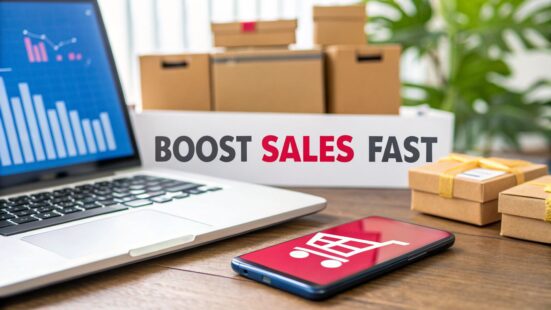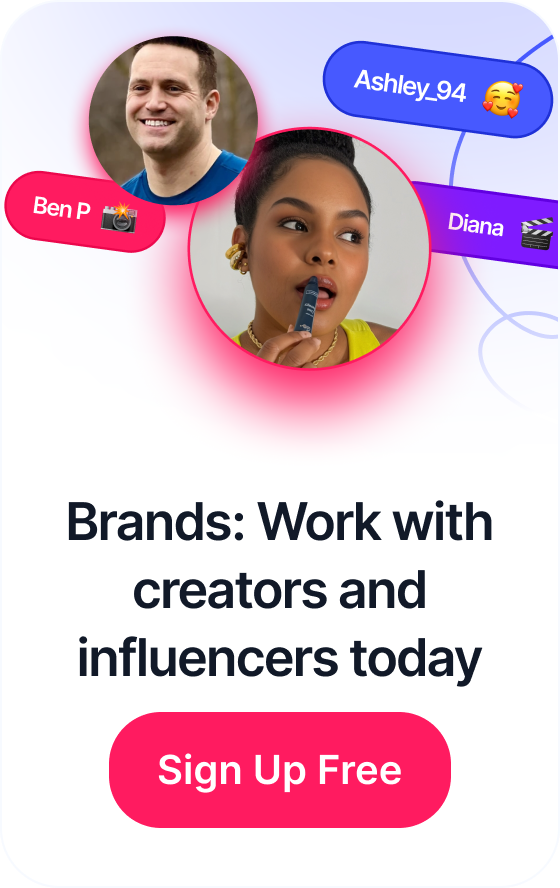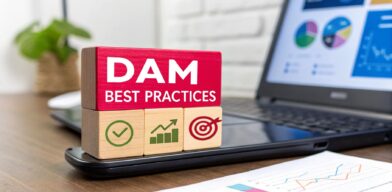 Boost Instagram Interaction Rate with Proven Strategies
Boost Instagram Interaction Rate with Proven Strategies
Are you getting plenty of clicks but not enough sales? It's a common frustration, but one you can absolutely solve. The trick isn't a single magic bullet; it's about methodically improving your entire sales process. Think of it as a well-oiled machine where every part—from how customers find you to how easy it is to pay—works together seamlessly.
This guide is designed to be your playbook for building that machine. We're skipping the vague, high-level advice and jumping straight into the practical, actionable steps that will make a real difference to your revenue. True growth comes from a holistic approach, not just pouring more money into ads.
A Look at the Growing Opportunity
The sheer scale of the online market is staggering. Global eCommerce sales are on a trajectory to leap from $5.3 trillion to $8.3 trillion between 2021 and 2025. That's a massive 55% jump in just four years. The driving force? Changing habits, especially the shift to mobile, which is predicted to make up over 70% of all online purchases by 2025. For more insights on these trends, you can check out the data on ClearlyPayments.com.
Success in this environment isn't about chasing every shiny new trend. It’s about mastering the fundamentals that influence how people shop and building a trustworthy system that consistently solves your customers' problems.
To give you a clear roadmap of what's ahead, we've broken down our approach into a few core pillars. Each one represents a critical area you need to master to turn visitors into repeat buyers.
Core Pillars for Boosting Online Sales
A summary of the key strategic areas this guide will cover to provide a quick overview of the essential components for sales growth.
| Strategy Pillar | Primary Goal | Key Actions |
|---|---|---|
| Conversion Rate Optimization (CRO) | Maximize sales from existing traffic | A/B testing, improving site speed, simplifying navigation |
| SEO and Content Marketing | Attract high-quality, organic traffic | Keyword research, creating valuable content, link building |
| Customer Experience & Personalization | Build loyalty and increase order value | Personalized recommendations, seamless support, loyalty programs |
| Checkout & Payment Optimization | Reduce cart abandonment | Streamlining checkout steps, offering multiple payment options |
Mastering these areas creates a powerful, self-reinforcing cycle that drives sustainable growth long-term.
The Psychology Behind the Purchase
At the end of the day, every "buy now" click is a human decision. Understanding why people decide to purchase is just as crucial as the technical setup of your store. This is where you can gain a real edge.
By weaving principles like urgency, social proof (like reviews), and reciprocity into your site, you build the trust and confidence needed to turn a hesitant browser into a happy customer. To dig deeper into the powerful mental triggers that lead to sales, exploring these strategies to boost online sales with consumer psychology is a fantastic starting point. It’s about building that psychological advantage into every step of your customer’s journey.
Table of Contents
Turn Your Storefront Into a Conversion Machine
Think of your website as your best and hardest-working salesperson. It’s on the clock 24/7, interacts with every single visitor, and carries the entire weight of convincing them to click “buy.” If you want to boost online sales, you need to arm this digital salesperson with the right tools, and that all comes down to Conversion Rate Optimization (CRO).
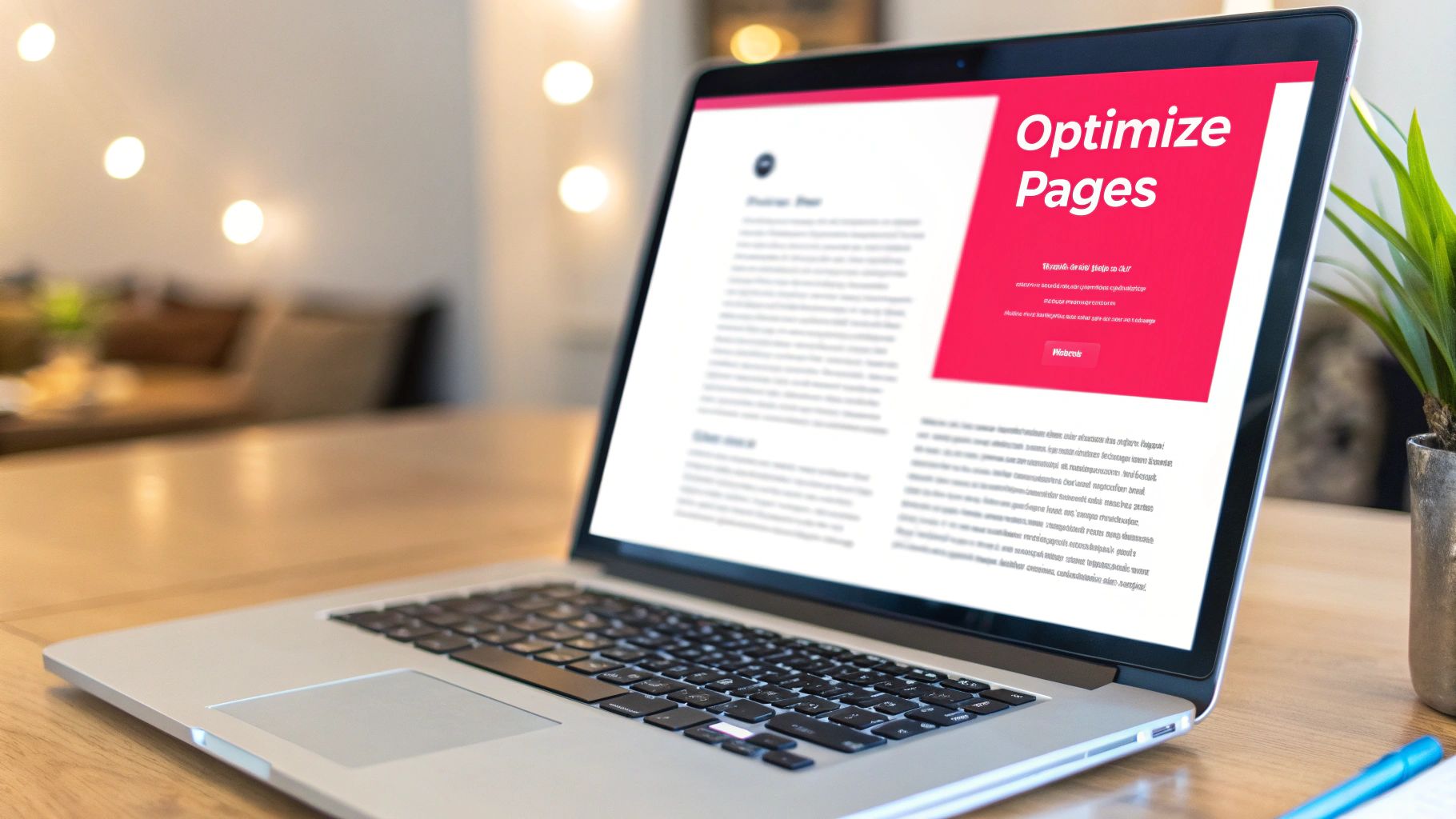
This isn’t about some flashy, expensive redesign. It’s about making a series of smart, data-driven tweaks that make shopping on your site easier, more intuitive, and far more trustworthy. The real goal here is to sand down any friction points that stand between a visitor’s curiosity and a completed purchase.
Create an Irresistible Visual Experience
Online, your visuals have to do all the heavy lifting. Shoppers can't touch, feel, or try on your products, so your photos and videos become their hands and eyes. Low-quality, pixelated images don’t just look bad; they scream “untrustworthy” and can kill a sale before it even begins.
To help customers feel like they're holding the product, focus on a few key things:
- High-Resolution Photography: Get professional, crystal-clear shots from every conceivable angle. Make sure you have a zoom function so people can get up close and personal with the details, whether it's the texture of a fabric or the finish on a piece of hardware.
- Lifestyle Shots: Show your product in the real world. A photo of a backpack on a white background is fine, but a shot of that same backpack on a hiker halfway up a mountain? That’s aspirational. It sells a story, not just a product.
- Product Videos: A quick video is the closest you can get to an in-person demo. It can show scale, features, and how something works in a way static images just can't match.
Getting your visuals right builds a massive amount of confidence and helps customers get over that natural hesitation of buying something sight unseen.
Write Product Descriptions That Actually Sell
Your product descriptions have a bigger job than just listing specs. They need to tell a story and, most importantly, solve a customer's problem. Ditch the technical manual jargon and start writing like a helpful sales assistant who knows exactly what the customer is looking for.
The secret is connecting features to tangible benefits. Instead of just saying "water-resistant material," try something like, "Stay dry and confident on your commute—our fully water-resistant fabric keeps your laptop and valuables protected, no matter the weather." See the difference?
Pro Tip: Always write for skimmers. Most shoppers scan a page before they decide to read it. Use short paragraphs, bullet points for the key features, and bold text to highlight the most compelling benefits. Make the good stuff impossible to miss.
This approach helps customers picture themselves using and benefiting from your product, which is a huge step toward the checkout.
Build Instant Trust with Social Proof
Let's be honest: people trust other people way more than they trust brands. That's precisely why social proof is one of the most potent tools in your e-commerce playbook. When a potential buyer sees that other people have already bought and loved your product, it validates their own interest and quiets that little voice of doubt.
Placing customer reviews, testimonials, and user-generated content (UGC) directly on your product pages can have a massive impact on your conversion rates. In fact, when you explore the benefits of https://joinbrands.com/blog/benefits-of-user-generated-content/, you see just how powerful authentic customer photos and videos can be for building credibility.
The move to online shopping isn't slowing down. Retail e-commerce is expected to account for 20.5% of all global retail sales by 2025, a solid increase from 18.5% in 2022. This trend highlights just how vital a strong online sales strategy is, with yearly e-commerce sales projected to reach an incredible $6.42 trillion by that same year.
Optimize for an Effortless Shopping Experience
Finally, none of the above matters if your website is a pain to use. A slow, confusing, or mobile-unfriendly site is a guaranteed sales killer.
Start by looking at your navigation with fresh eyes. Can a brand-new visitor find what they want in just a few clicks? Your categories should be crystal clear, and your search bar should be front and center. The 'Add to Cart' and 'Checkout' buttons need to be bold, obvious, and impossible to miss.
For those selling on major platforms, the same core ideas apply. You can learn a ton about turning casual browsers into buyers by digging into strategies for boosting your Amazon conversion rate.
Above all else, your site has to be flawless on mobile. With most of your traffic likely coming from smartphones, a clunky mobile experience is like putting a "closed" sign on your digital front door. Every single element, from product images to checkout forms, must be built for the small screen first.
Attracting Quality Traffic with Smart SEO
Let's be honest. You can have the most beautiful, persuasive online store in the world, but if no one can find it, you're not going to sell a thing. Getting your store in front of the right people—those actively looking for what you sell—is what truly fuels your business.
This is where Search Engine Optimization (SEO) comes in. Think of it as making your store irresistible to search engines like Google. When you get SEO right, you don't just get more visitors; you get better visitors who are ready to pull out their wallets.
Find Out What Your Customers Are Actually Searching For
Before you can rank on Google, you have to get inside your customers' heads. What words and phrases are they typing into that search bar? This is keyword research, and it's the bedrock of any solid SEO plan.
Don't just guess. You need to use real data to find keywords that show someone is ready to buy. There's a world of difference between a search for "what are running shoes" and "best running shoes for flat feet." The first is casual browsing; the second is a problem looking for a solution. You want to capture that second searcher.
Here’s a great example of how one well-optimized product page can show up for a bunch of different, yet relevant, search terms.
This shows that a single page can pull in traffic from both broad searches and super-specific ones, giving you the best of both worlds.
Weave Keywords into the Fabric of Your Store
Once you’ve got your list of golden keywords, it’s time to put them to work. The key is to sprinkle them naturally throughout your site. This is how you signal to search engines what each page is all about.
Here's where to focus your efforts for the biggest impact:
- Product Pages: This is ground zero. Your product titles, descriptions, and even the alt-text for your images should include relevant keywords. Be clear, be descriptive, and think like your customer.
- Category Pages: These pages are SEO gold. They're perfect for broader terms like "women's leather jackets" or "organic dog food."
- Blog Posts: A blog is your secret weapon. Writing genuinely helpful articles like "How to Style a Leather Jacket" attracts people who are just starting their research. You can guide them from curious reader to loyal customer.
My Two Cents: Don't just stuff keywords in for the sake of it. Google is smart enough to see through that. Write for humans first. Your content has to be genuinely helpful and easy to read.
Don't Neglect Your Technical SEO
Technical SEO is all the "under the hood" stuff that helps search engines find and understand your site. Ignoring it is like building a gorgeous house on a cracked foundation—it’s just not going to hold up. For an online store, two things are absolutely critical: site speed and the mobile experience.
A slow website will absolutely murder your sales. We’ve all been there. If a page takes more than a couple of seconds to load, we hit the back button. Studies show that a delay of even one second can slash your conversion rate.
And today, mobile isn't just important; it's everything. The majority of online shopping now happens on a phone. If customers have to pinch and zoom just to read your product descriptions, they're gone. The experience has to be smooth and intuitive from the moment they land on your site.
Give Your Growth a Boost with Paid Ads
SEO is a marathon, not a sprint. It delivers incredible long-term value, but sometimes you need sales now. That's when you turn to paid advertising. It’s a direct, fast, and incredibly targeted way to get your products in front of people who are ready to buy.
A couple of channels are must-tries for e-commerce:
- Google Shopping Ads: You’ve seen them. Those product images at the top of Google search results? They’re ridiculously effective. Shoppers see a picture of your product, the price, and your store name right away.
- Social Media Ads: Platforms like Instagram and TikTok are discovery platforms. You can get your brand in front of the perfect audience based on their interests and online habits, even if they weren’t actively searching for you.
The metric that matters most with paid ads is your Return On Ad Spend (ROAS). For every dollar you put in, are you getting two, three, or even ten dollars back in revenue? Start with a small budget, test everything—your images, your ad copy, your audience—and once you find a winner, scale it up.
Make the Customer Journey Personal
In a crowded market, a generic, one-size-fits-all approach is a quick way to get lost in the noise. If you really want to boost online sales, you have to make each customer feel seen and understood. Personalization is what turns a simple transaction into a loyal relationship, making shoppers feel like your store was built just for them.

This isn’t about some far-off, futuristic tech. It starts with simple, powerful tactics that use the data customers are already giving you to create a smoother, more relevant shopping experience. The real goal is to anticipate their needs and guide them to products they’ll genuinely love.
Personalize the On-Site Experience
Your own website is the best place to start tailoring the experience. When a customer browses your store, they’re dropping valuable clues about what they like. Using that information in real-time can make a huge difference in how long they stick around and whether they buy.
Here are a few simple but incredibly effective on-site tactics:
- "Recently Viewed Items": This is a basic feature, but it's essential. Think of it as a digital breadcrumb trail, making it effortless for shoppers to find their way back to products they were considering. No more frustrating searches for that one thing they almost bought.
- Smart Recommendations: Modern AI tools can analyze browsing behavior, past purchases, and what similar customers bought to power a "You might also like" section. When done right, it's genuinely helpful, not just a random assortment of products. This is one of the easiest ways to increase your average order value.
These small touches make your site feel more intuitive and responsive to each person's individual journey.
Leverage Automated Email Journeys
Email is still one of the most powerful channels for personalized marketing, period. By setting up automated workflows, you can send timely, relevant messages that recapture lost sales and bring people back for more. These automated systems are a core part of modern marketing, and you can dive deeper into these strategies in our guide to eCommerce marketing automation.
Key Insight: Abandoned cart emails are a goldmine. Seriously. A simple, well-timed reminder that a customer left items in their cart can recover a huge percentage of otherwise lost sales. The best ones often include a gentle nudge, a customer review of the item, or even a small, exclusive discount to close the deal.
It goes beyond just abandoned carts, though. You can create customer segments based on their purchase history. For instance, if someone just bought a pair of running shoes, you can automatically send them a special offer on running accessories a week later. That kind of targeting feels less like spam and more like a helpful suggestion from a brand that gets them.
Tailor Your Strategy for a Global Audience
As your business grows, understanding regional differences becomes critical. What works in one market might completely fall flat in another. China, for example, is the world's largest eCommerce market and is set to hit $2.2 trillion in 2025. Meanwhile, emerging markets like Latin America are projected to see 22% growth from 2023 to 2026.
These diverse markets have unique preferences, from mobile shopping habits in Asia to the rise of social commerce in the US. This data shows that a global strategy must be localized. This might mean offering different payment methods, tweaking your marketing messages, or highlighting products that are popular in a specific region.
From Data to Dollars
At the end of the day, personalization is all about using customer data to create a seamless, one-on-one journey. It shows you're paying attention.
When you put these strategies into practice, you move beyond just selling products. You start building relationships, fostering loyalty, and creating a shopping experience that keeps customers coming back. This is how you create sustainable growth and turn casual shoppers into lifelong fans. The result isn't just a single sale—it's a massive increase in customer lifetime value.
Fixing Your Leaky Checkout Funnel
You've done all the hard work. You built a great product page, wrote killer copy, and guided a shopper right to the finish line. Then, poof. They vanish just before hitting "Pay." It’s not just a frustrating moment; it’s a massive red flag that your checkout process is losing you money. A high cart abandonment rate is one of the biggest silent killers of online sales.
The checkout isn't just a transaction. It's the final handshake, the moment of truth. If it’s clumsy, confusing, or full of surprises, you’re basically showing customers the door. The good news? Plugging these leaks is all about removing friction and building trust when it matters most.
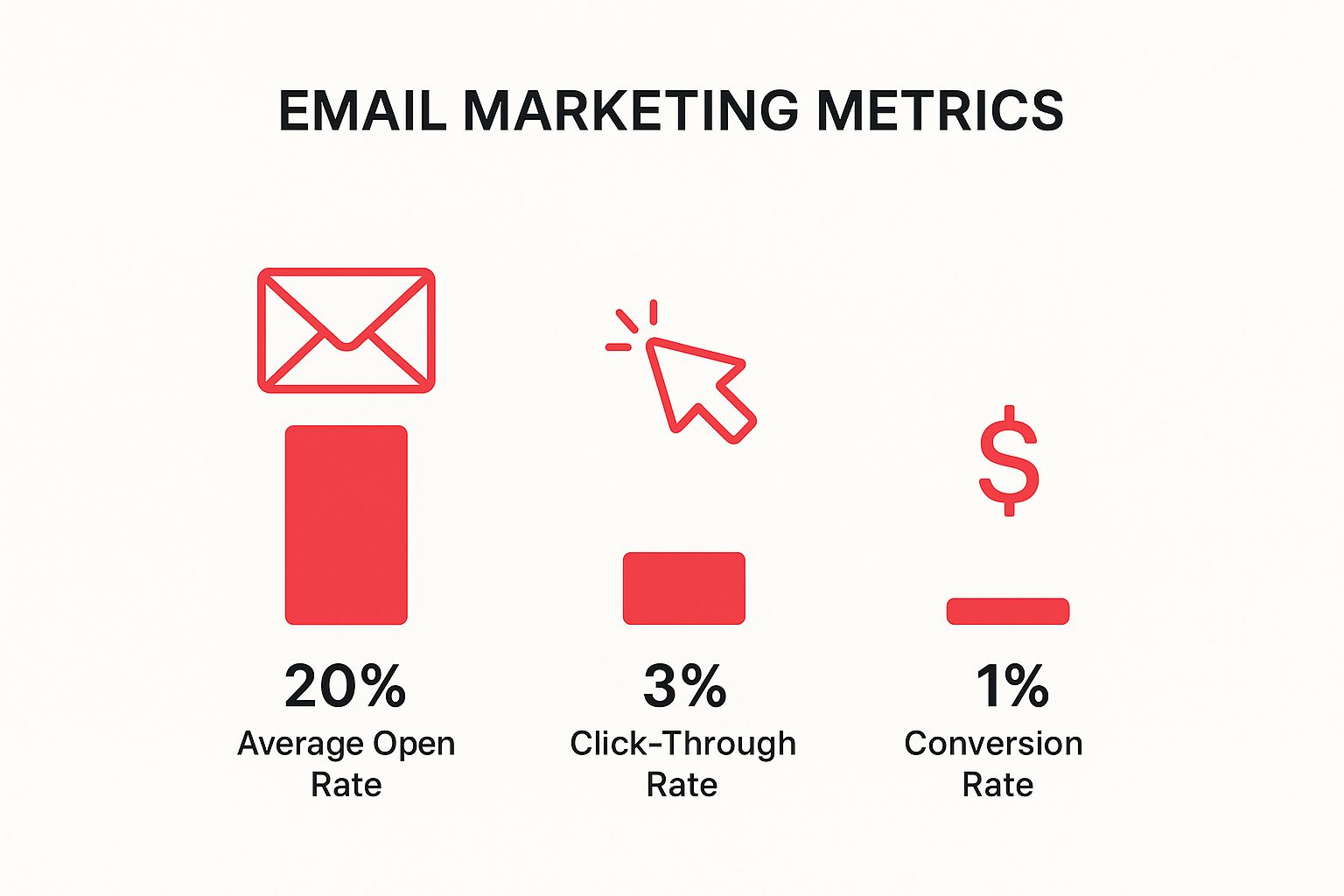
Eliminate Unnecessary Hurdles
Every single click, every extra form field, is another opportunity for a customer to get distracted or second-guess their decision. Your goal should be to make the path from cart to confirmation as short and direct as humanly possible. Think of it like an express lane—people are there to get in and get out, not to fill out a survey.
One of the biggest hurdles you can get rid of right now is forced account creation. Demanding a new customer create a password and fill out a profile before they can give you their money is a notorious conversion killer.
Pro Tip: Always, always offer a guest checkout option. You can easily invite them to create an account after the sale is complete. This one simple change shows you respect their time and can make a huge difference in how many people complete their purchase.
Cart abandonment is a multi-faceted problem, but it often boils down to a few key friction points. By understanding why shoppers leave, you can implement targeted fixes that directly address their concerns.
Here’s a look at the most common culprits and how to solve them.
Top Cart Abandonment Causes and Solutions
| Reason for Abandonment | Impact on Sales | Effective Solution |
|---|---|---|
| Unexpected Costs | This is the #1 reason. It immediately erodes trust and makes your pricing feel deceptive, leading to immediate cart abandonment. | Display shipping costs, taxes, and any fees directly on the product page or within the cart itself. No surprises at the final step. |
| Forced Account Creation | Creates a significant barrier for new or impatient customers. It adds time and friction to what should be a quick process. | Always offer a prominent guest checkout option. You can prompt for account creation on the confirmation page post-purchase. |
| Complex Checkout Process | Too many steps, fields, or pages can overwhelm and frustrate shoppers, causing them to give up before finishing. | Simplify your checkout form to only ask for essential information. A one-page or accordion-style checkout often works best. |
| Limited Payment Options | Shoppers have strong preferences. If their trusted method isn't available, they're likely to leave rather than enter new details. | Offer a diverse mix: major credit cards, digital wallets (Apple Pay, Google Pay), and Buy Now, Pay Later services (Klarna). |
| Security Concerns | A checkout page that looks outdated or lacks trust signals (like SSL certificates) can make customers hesitant to enter payment info. | Display security badges (SSL, McAfee), use a professional design, and provide clear privacy policy links to build confidence. |
By systematically tackling these common issues, you can turn a leaky funnel into a smooth, conversion-friendly experience that encourages customers to follow through.
Be Radically Transparent About Costs
Have you ever filled your cart, proceeded to checkout, and then been hit with a jaw-dropping shipping fee out of nowhere? It's an instant deal-breaker. Surprise costs are the single biggest reason people abandon their carts because it feels like a bait-and-switch.
To stop this from happening, be upfront about every single cost, as early as you possibly can.
- Show Shipping Costs on the Product Page: Use a shipping calculator or offer clear flat-rate options so customers see the "all-in" price before they even commit to adding an item to their cart.
- Include Taxes and Fees Early: Integrate a tax calculator that updates the total directly in the shopping cart, not just on the final payment screen.
Total transparency builds incredible confidence. When the price a customer sees in their cart is the exact price they end up paying, there are no bad surprises, and they’re far more likely to click "Complete Purchase."
Offer the Payment Options They Actually Use
The very last step is getting paid. If you don’t offer the payment method your customer trusts and prefers, you might as well have a broken "Buy Now" button. Shoppers today expect a range of fast and secure ways to pay that go way beyond just typing in credit card numbers.
To cover all your bases, make sure your checkout is packed with a mix of modern and traditional options:
- Digital Wallets: Services like Apple Pay, Google Pay, and PayPal are non-negotiable these days. They enable one-click payments, which is the gold standard for a frictionless checkout, especially on mobile.
- Major Credit Cards: This is the absolute baseline. You have to accept Visa, Mastercard, American Express, and any other major cards relevant to your audience.
- Buy Now, Pay Later (BNPL): Options like Klarna or Afterpay are incredibly popular. They let customers split larger purchases into smaller, interest-free payments, which can seriously boost conversion rates on higher-ticket items.
Giving customers a variety of payment methods removes one final, critical piece of friction. You’re letting them pay how they want to pay, and that’s often the final nudge they need to complete the sale.
Bringing It All Together for Lasting Growth
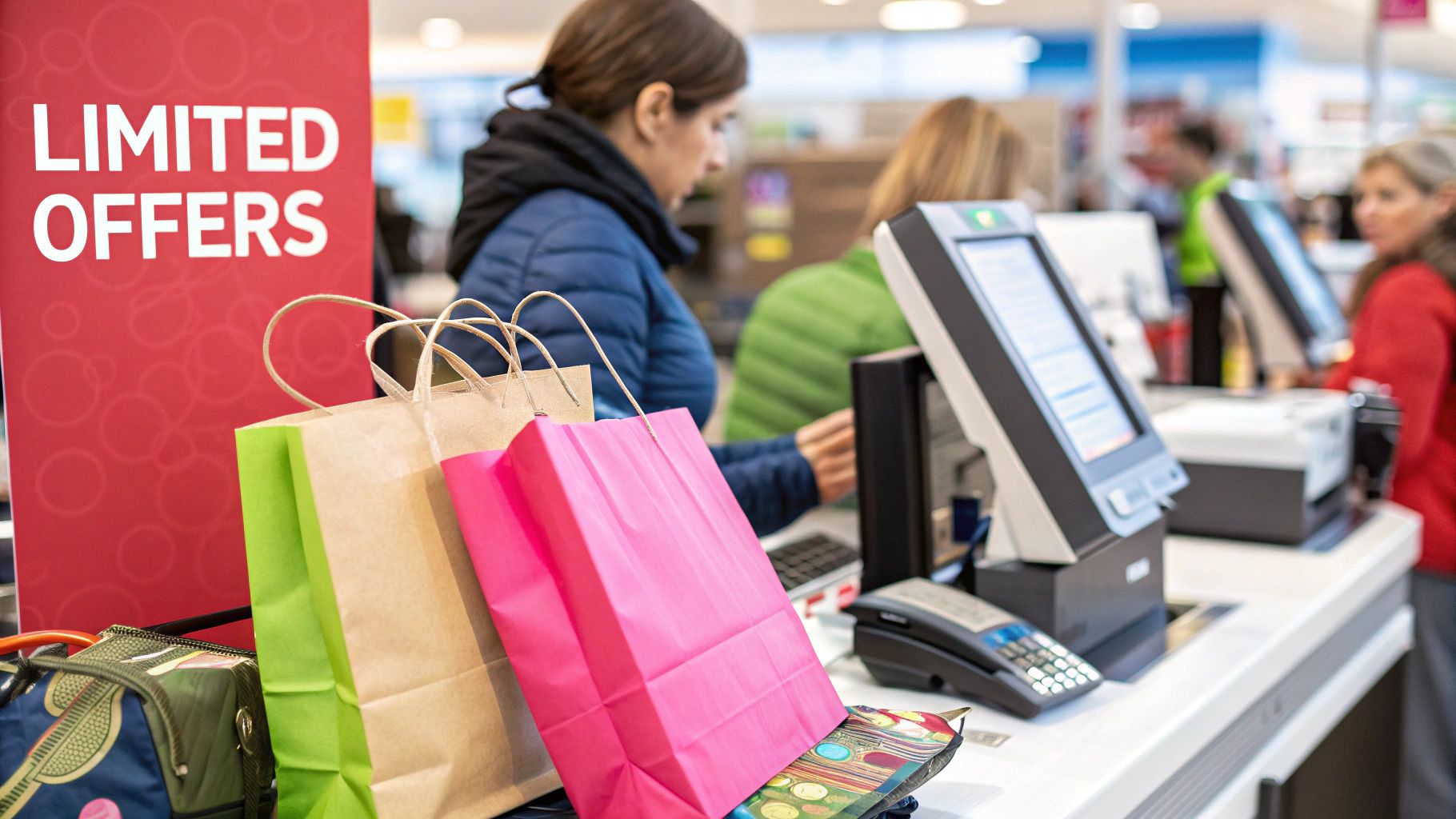
We've covered a lot of ground, from mastering SEO to creating a checkout process so smooth customers barely notice it. Each tactic is a solid piece of the puzzle. But the real magic happens when you stop thinking of them as a simple checklist and start seeing them as a single, interconnected system that drives your business forward.
Sustainable growth isn’t about a one-off campaign or a single clever trick. It's born from a commitment to constant, deliberate improvement. This is where you shift from just doing things to building a strategic growth engine.
Never Stop Testing and Improving
Think of the most successful online stores you know. I can almost guarantee they treat their sales process like a living, breathing thing. They're constantly tinkering, forming a hypothesis ("What if we change the button color?"), testing it out, and letting the data tell them what to do next.
This is the mindset that separates the stores that plateau from the ones that achieve predictable, year-over-year growth.
It's all about creating a simple feedback loop for your business:
- Make a Change: Pick one thing and start small. Maybe you rewrite the product description for your best-seller or remove one field from your checkout form.
- Measure Everything: Watch your key metrics like a hawk. Did conversions tick up? Did your bounce rate drop? Get specific.
- Dig for the "Why": The numbers are only half the story. Why did customers react the way they did? What does this tell you about their motivations?
- Refine and Repeat: Take what you learned and apply it. If it worked, do more of it. If it bombed, learn the lesson and try something new.
This isn't about getting it perfect on the first try. It’s about making your store just a little bit better, every single day.
The goal isn’t to find one silver bullet that fixes everything. It’s to make hundreds of small, data-backed improvements that compound over time into massive results.
Building Your Action Plan
To put this into practice, you need a plan. The best way to start is by prioritizing based on impact versus effort.
Go for the low-hanging fruit first. These are the quick wins that can give you an immediate boost. Think things like adding a guest checkout option or beefing up the copy on your top three product pages.
From there, map out your bigger projects. This could be something like a full-scale SEO content strategy or setting up sophisticated, personalized email flows.
As you roll out these changes, always keep a close eye on your customer acquisition costs. You need to know if your marketing dollars are actually working. If you're not sure where to start, our guide on how to calculate cost per acquisition is a great resource for tracking the ROI of your efforts.
By consistently testing, learning, and refining your approach, you're not just hoping for growth—you're building a resilient and predictable foundation for it.
Frequently Asked Questions
Even with the best game plan, questions are bound to pop up. Let's tackle some of the most common ones I hear from business owners who are working to drive more online sales.
How Quickly Can I Expect To See Results?
This is the million-dollar question, and the honest answer is: it depends entirely on the tactics you're using. Some moves pay off almost immediately, while others are a slow burn.
For example, if you streamline your checkout—say, by adding a guest option—you could see a drop in abandoned carts and a bump in sales within just a few days. A targeted ad campaign can also bring in new traffic and sales almost overnight.
On the other hand, core strategies like SEO and building a content library are long-term plays. You're typically looking at 3-6 months before you see a real, significant uptick in organic traffic. The key is to balance short-term tactics for quick wins with these foundational strategies that build lasting success.
What Are The Most Important Metrics To Track?
Revenue is the ultimate scoreboard, of course, but it doesn't tell the whole story. To truly understand what's working (and what's not), you need to look at the metrics that lead to that final number.
When it comes to sales performance, these are the KPIs you should live by:
- Conversion Rate: This is your north star. It's the percentage of visitors who actually buy something, telling you exactly how effective your site is.
- Average Order Value (AOV): Simply put, how much does the average customer spend in a single purchase?
- Customer Lifetime Value (CLV): This is the total amount you can expect a single customer to spend with you over time. It's a goldmine for understanding your long-term health.
- Cart Abandonment Rate: What percentage of people add items to their cart but bail before paying? A high number here is a major red flag.
Don't forget to watch your traffic sources, too. Keep an eye on your organic traffic growth, the cost per acquisition (CPA) for your ad campaigns, and the click-through rates (CTR) on your emails and ads.
Do I Need A Big Budget To Boost Online Sales?
Not at all. While having a hefty budget to play with is nice, some of the most impactful strategies for growing online sales are about brainpower, not bankroll.
Start with the low-cost, high-impact fundamentals. Things like improving your site speed, writing compelling product descriptions, and building an email list are all incredibly effective and cost more time than money. You can also build a ton of trust and social proof by engaging with your community on social media and encouraging them to share their own content—all without a huge ad spend.
Think of paid ads as an accelerator, not a requirement. Start with a small, manageable budget to see what resonates with your audience. Once you've got a solid foundation with good conversion rates, every dollar you eventually spend on advertising will work that much harder for you.
Ready to connect with creators who can generate authentic content and drive real sales? JoinBrands makes it easy to find and collaborate with over 250,000 creators, from TikTok Shop Affiliates to Amazon influencers. Launch your first campaign today at https://joinbrands.com.
